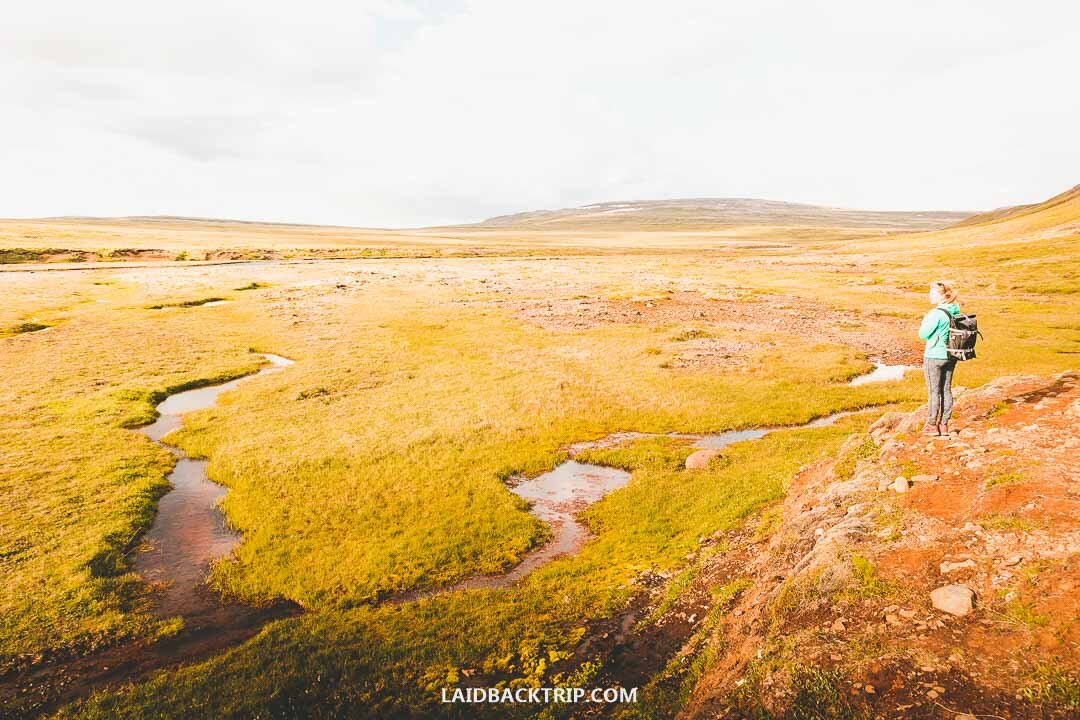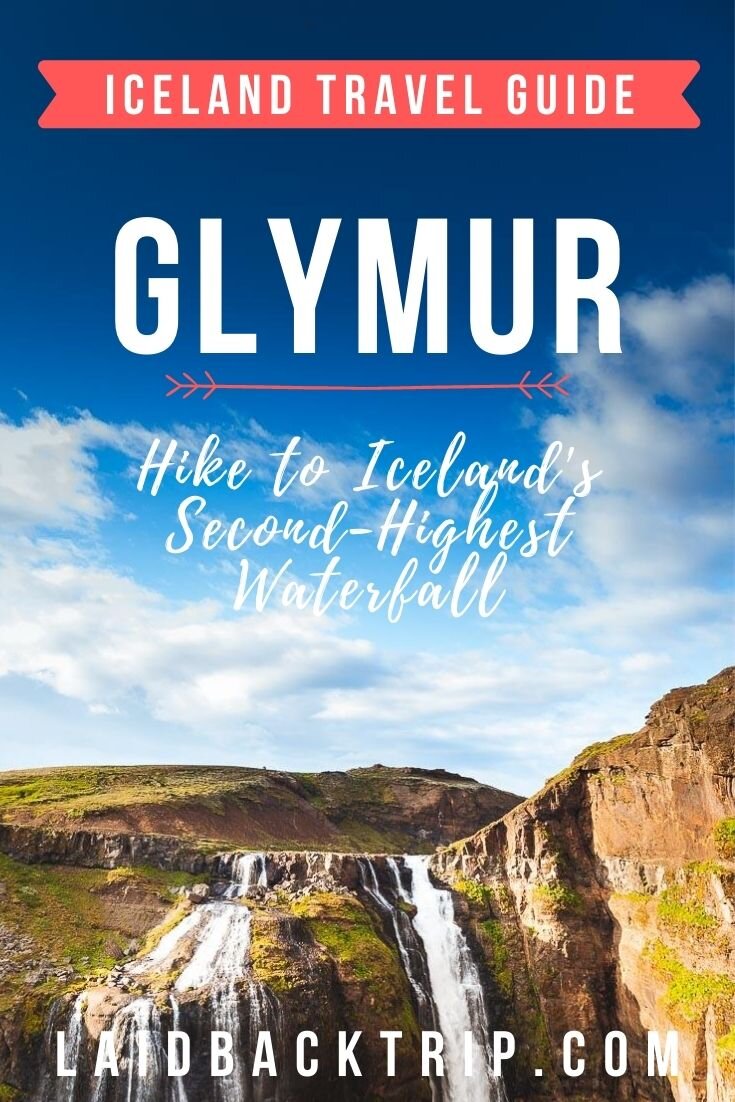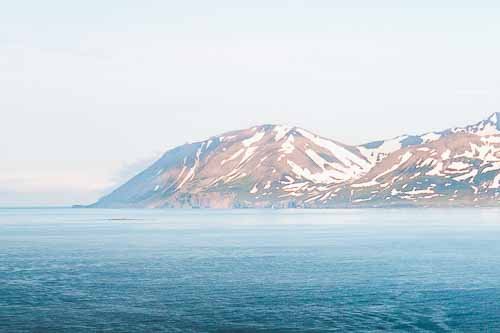A Guide to Glymur Waterfall Hike in Iceland
Glymur Waterfall hike to Iceland's second-highest waterfall is one of the best trails near Reykjavik. In this Glymur Waterfall travel guide, we share with you tips on hiking the Glymur hike loop, including information on location, tips on how to get, where to stay, what to pack, and when to visit.
We have a confession to make. The headline of this article was at first Glymur: Hike to Iceland's highest waterfall, but later we decided that our readers could find it a bit misleading.
Honestly, we felt that the second-highest waterfall did not sound that catchy, plus there were more significant reasons why we wanted to make sure you will find hiking the Glymur trail inspiring.
Why did we think this way?
Until 2007, Glymur, with its 198 meters, was really the highest waterfall in the country of fire and ice, but that very year, Morsarjokull Glacier started to melt, and a new waterfall, a giant with 228 meters named Morsarfoss, was born.
Unfortunately, Morsarfoss is very hard to access, and unless you know how to use special mountain equipment such as axes and crampons, it is necessary to satisfy with a viewpoint that is several kilometers away.
So to be really transparent, Glymur is officially known as the second tallest waterfall in Iceland, or better, the highest well-accessible waterfall in the country.
Hiking to Glymur waterfall was one of the best things we did during our two-week road trip around Iceland.
Glymur Hike
First of all, the weather was great, we felt relaxed as we made it to the area near Reykjavik on time, and our trip was coming to an end, and we already knew that this ultimate last-minute adventure was successful.
Glymur hike is one of the most popular treks in Iceland for four reasons.
It is close to the capital city, the hike is very rewarding from the very beginning, it is not that challenging, and when you decide to make a loop, it has a nice adventurous touch that every outdoorsy traveler must appreciate.
We were indeed wondering how it is possible the country was blessed with so many waterfalls all the time we were in Iceland.
Until now, we saw gems such as Seljalandsfoss, Skogafoss, Dettifoss, Godafoss, or Dynjandi, and we were by no means overwhelmed; rather the contrary, we were still driven to see yet another photogenic cascade.
And moreover, we were thinking how is it possible all those waterfalls are such easily accessible? Sometimes, we felt we do not deserve to see so much beauty with almost no effort.
Well, Glymur made it up for us as it involved a bit of hiking. This Glymur hike travel guide aims to help you plan the Glymur waterfall loop, a hike you cannot miss in Iceland.
From how to get to the Glymur parking lot, what to expect from the trail, when is the best time to visit, to where to stay, we've got you covered.
Trail Description
Before you include this natural attraction in your Iceland itinerary and start preparing for the Glymur hike itself, there is a few practical information to know before you go.
First of all, it is possible to make a loop that includes crossing Botnsa river on the log and then wading across the very same river at the top of the waterfall.
Of course, it is also possible not to make a loop but walk the same way back if you are not comfortable entering the cold water.
Either way, to get to the east side of the gorge and get the best views, you will have to cross the log at least once on the way up and then again on the way down.
In case you do not want to cross the river, there is an option to hike along the western edge.
In this case, you do not need to cross the river, but the views are a bit limited (you will see just the cascade coming from the waterfall, not the waterfall in its full glory), and not that spectacular.
Both the loop and in-and-out trail are similarly long, approximately 7.1 kilometers roundtrip, and the elevation gain is 420 meters.
The first part of the trail leads uphill, and the second half descends back to the parking lot, but given the rocky terrain, each way will take you approximately the same amount of time.
It usually takes three to four hours to finish the Glymur hike, depending on your pace.
How to Get to Glymur Parking Lot
The Glymur hike trailhead lies close to the mouth of Hvalfjordur Fjord, which means the road is also very scenic and worth your attention.
The best way to get to the parking lot is by rental car.
In case you do not plan on renting a car in Iceland, your only option is to take a Glymur Tour from Reykjavik because there is no public transport.
To get to the parking lot, you need to get to road number 47, circumnavigating the fjord, and then turn to an unpaved road (nameless) that ends at the trailhead.
Even though the trailhead is not well-signposted, you will easily find the Glymur hike trailhead on your GPS.
You do not need a 4WD outside the winter season; our 2WD campervan was absolutely enough.
To get to the parking lot you need to get to road number 47 circumnavigating the fjord, and then turn to an unpaved road (nameless) that ends at the trailhead.
Even though the trailhead is not well-signposted, you will easily find Glymur hike on your GPS.
You do not need a 4WD outside the winter season, our 2WD campervan was absolutely enough.
Glymur Hike Experience
We would rate the Glymur hike moderately difficult, so every averagely fit traveler should be able to enjoy it, just do not underestimate the ever-changing weather.
Trailhead
When we reached the parking lot it was already 5 PM (which is ok in the summer because the sunset is around midnight), so we knew we must start as soon as possible as we did not want to arrive at our accommodation too late.
At the beginning of the trailhead, we took a photo of the information board that describes the path, and there is also a small map helping travelers to navigate in the area.
The area around Glymur was a bit different than we were used to in Iceland.
Even though the views were wonderful, we could see small trees around, which is not usual in this barren volcanic country.
Trail
The first part of the trail was relatively uneventful, and a wide and rocky path led us to Botnsa River.
We did not see any signs, and we noticed there were two paths, upper and lower one, but they merged near the river - we chose the lower one and returned via the upper one, but there is really no difference.
After some time, we reached a cute and photogenic cave - the trail leads through it, and now we could already spot the river and a large group ahead of us that was crossing the river.
Log Crossing
I must admit that I do not feel comfortable when crossing rivers or slippery boulders, so at first, the sight of the log across the river scared me.
I knew all the time there would be this point, but it is simply much worse when you see the crossing is inevitable in order to get the views.
But no worries, I made it, and you will make it too. The only tricky part is to cross a few rocks to reach the log.
Once you are on the log, there is a rope you can hold to, and when walking slowly, you'll be on the other side of the river before you know it.
The situation might be a bit different when it rains as the log might be slippery. Be super-careful.
Ascend
On the other side of the river, the path started to ascend quite steeply at some points. It did not take long, and wonderful views started to reveal in front of us.
The path often leads very close to the edge, so be careful where you step, especially when you are a photographer as we know, it is often easy to lost orientation in pursuit of taking the best picture.
We climbed around the edge higher and higher, and soon we spotted Glymur in its full glory.
The canyon where the river flows has incredibly steep walls, and except for this and the exceptionally high waterfall, we could not get enough photos of birds flying around.
Birdwatching
We had already visited some of the top birdwatching spots such as Dyrholaey, Borgarfjordur Eystri, or Latrabjarg, but this canyon has a lot to offer too.
No puffins, but still, it was pretty awesome.
After we spotted Glymur waterfall for the first time, we were accompanied by the incredible views the higher we went.
In case you do not make a loop, it is completely up to you where you turn back and which viewpoint will be your last.
We planned to make the loop, so we continued up, above the waterfall, where the ascend stops and a meadow appears.
Wading a River
There is no signposted place where to cross the river, but the sign at the beginning of the trailhead said it is approximately 300 meters above the waterfall.
It is much easier when you see hikers ahead of you, but the rule of thumb is to find a spot where the river is wider, and the stream is not that strong.
As we did not want to get wet, we took off the shoes.
We know it is not the best style to cross the river, but the rocks at the bottom were not that sharp, and we made it safely to the other bank.
The water was refreshing, to put it mildly.
Return
Then we just needed to walk back to the parking lot; the path now led us all the way downhill, now offering the views of a narrow canyon.
After a few hundreds of meters of descending, you'll see a sign and can choose from two trails leading to the parking lot.
Both trails are similarly long, but the one that turns right is supposedly easier.
We chose the path that led us along the edge of the canyon, and we descended quickly; the rocky terrain was now a bit more challenging, but nothing terrifying.
We thought we lost the trail for a while because of the thick vegetation, but we knew we must go down, and after thirty minutes or so, we reached the cave.
From here, we knew it is just a comfortable flat walk to our car.
We spent a lot of time taking photos of Glymur waterfall, and to be honest, we enjoyed this hike much more than expected.
In the end, the whole trek took us approximately three hours, so we believe even slower hikers should be able to make the loop within four hours.
Travel Insurance
We never leave home without travel insurance that was designed to cover our expenses if something goes wrong during the trip.
Travel insurance protects against theft, flight delays, injury, illness, cancellations, and much more.
World Nomads provides travel insurance for travelers to cover their trip essentials, including sports and adventure activities.
SafetyWing is affordable travel insurance for backpackers, long-term travelers, and digital nomads.
Travel smarter and safer!
When to Go
The best time to visit Glymur is between spring and autumn because only during this time is there the log across the river that will take you to the best viewpoints.
Well, we know it sounds a bit vague, but it is how it is.
Locals put the log in place when the conditions allow it and remove it again during the winter, or when the conditions are still winter-like, muddy, slippery, and when the water level is high.
In case you travel around Iceland during the shoulder season, it is always good to have a backup plan in case the log to safely cross the river is not available.
Of course, it is possible to wade across as well, but we do not recommend it, especially when the flow is strong.
You can also walk the path on the west side all year round, but the views are for sure better from the eastern side.
Therefore, the best time to do the Glymur hike is in the summer, between June and August.
Not only should you be able to cross the Botnsa River, but wading across the river to the other side should be doable, and if it is possible to say it, a bit more comfortable as outside the summer season, the water is freezing cold.
Time of the Day
What is the best time of the day to visit Glymur?
Well, if you take into account that the trail is within driving distance from Reykjavik, Golden Circle, but also Snaefellsnes Peninsula, it does not come as a surprise that this place is heavily trafficked.
It is best to start the hike either early in the morning or later in the evening to avoid crowds.
It is good to know that the hiking summer season coincides with a phenomenon midnight sun, which gives travelers plenty of time to start the trek.
We arrived at the parking lot at 5 PM, which is normally not the best time to commence hiking, but here in Iceland, it was absolutely fine at the beginning of July.
What to Pack
To reach the Glymur waterfall, you must make an effort - it is one of the few attractions in Iceland, where it is not enough just to step outside the car.
Therefore, your clothes should reflect the ever-changing weather.
Sturdy hiking boots are, in this case, a must because the terrain is rocky, and the log can be slippery, so the more quality soles you have, the better.
In case you plan on making the loop and do not want to wade across the river barefoot, pack either wading boots or water shoes.
The rest of your equipment depends on you, but we always carry a rain jacket (or rain poncho), rain pants, a water bottle, and a daypack.
If you have bad knees, it is a good idea to bring trekking poles with you for the descend.
Where to Stay Near Glymur Waterfall
Glymur waterfall is very well-accessible; therefore, you can easily incorporate it into your itinerary.
As the most common way to get around Iceland is road tripping, it is quite hard to suggest to you the best place to stay near Glymur waterfall as we do not know where your steps lead before and after.
According to our own experience, you can spend a night either in Hvalfjordur or Borganes, which are nearby, or in Arnarstapi (or anywhere else on Snaefellsnes Peninsula), or the capital Reykjavik.
We've selected the best hotels near Glymur waterfall to make your trip as smooth as possible.
Hvalfjordur | Hotel Glymur - Only 16 kilometers from Glymur, this accommodation offers wonderfully decorated rooms. Some of the rooms have a sea view, so make your reservation well ahead to secure one of them.
Arnarstapi | Arnarstapi Hotel - Comfortable, well-designed rooms and a peaceful atmosphere makes this place an oasis in cold Iceland.
Reykjavik | Hotel Klettur - If you are looking for accommodation in the capital city that is decent but that will not break the bank, this conveniently located hotel is a good choice.
Borgarnes | B59 Hotel - New modern hotel offers travelers much-needed comfort. Borgarnes is a well-situated town from where you can continue your Iceland road trip.
Travel Resources
Here you can find links to all the travel resources we use and which you might find helpful when planning your next holiday.
Accommodation: When looking for accommodation, we usually search hotels via Booking.com or Hostelworld.
Tours: Although we love to travel independently, some places are better to visit with a guided tour.
We prefer GetYourGuide for its easy-to-use interface and solid reputation. Another great alternative is Viator.
Rental Cars: When going on a road trip, we always use Rentalcars.com, a reliable site for booking a rental car in advance.
Flight Tickets: When looking for flight tickets, you can search Skyscanner to find the best price.
Travel Insurance: World Nomads and SafetyWing cover against risks of travel.













